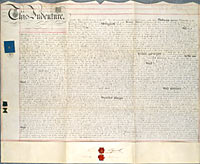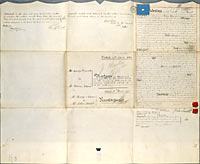Mortgage by conveyance
Purpose
A conveyance of property in order to secure a loan of money.
Features of mortgages by conveyance
- 17th-19th centuries
- large
- written on parchment
- usually written in English
- indenture (wavy top edge)
- seal
Important words and phrases
This type of deed is also sometimes known as a 'mortgage in fee'. It takes the form of an ordinary conveyance, and so can look like a feoffment, a bargain and sale, or a lease and release. It can be very easy to assume that it is a simple conveyance.
However, look out for the words 'Providing Always...'. In a lease and release, these words will appear in the release only. In this clause, it is stated that if the mortgagor pays back the 'principal sum' (the amount of money being lent) plus interest to the mortgagee on a certain specified date and place,
'then this Indenture ... shall cease determine and be utterly void'.
The date for repayment is usually given as one year from the date of the mortgage. However, this does not mean exactly what it appears to say. In most cases, mortgagees were happy with the interest being paid once or twice a year. Many properties remained mortgaged for years or even decades, because the mortgagor was unable or unwilling to pay back the principal sum and 'redeem' the mortgage; and because the mortgagee treated the mortgage as an investment which brought in a steady income. Often, mortgage deeds are endorsed with receipts for the payments made each year.
The mortgage deed will normally include a covenant to reconvey the property when the money is paid in full. This was recorded in a deed of 'Reconveyance', which was either made out specially as a separate deed, or more often was written onto the back of the original mortgage.
If an additional sum of money was required by the mortgagor, this might be lent to him by the mortgagee and added to the original mortgage amount, as long as the combined sum was not more than the value of the land. A 'Further Charge' was a fairly simple deed reciting the original mortgage, and stating the amount of money added.
Examples
Ne 6 D 2/37/33 - Mortgage [with endorsed reconveyance] from George Deverill to Henry Nelson of messuages and premises in Brewhouse Yard, Nottingham, Nottinghamshire for securing £300 and interest; 17 Apr. 1863


View this deed: front | reverse
This is a good example of a mortgage by conveyance and a reconveyance written on the same document. It is written on a large sized piece of parchment, 73 cm wide by 59 cm high and takes the form of a standard grant or conveyance (following the Act of 1845). It relates to a public house in Nottingham called 'The Gate'. From its description in the mortgage deed the pub must have been quite similar to its neighbour, the 'Trip to Jerusalem', which is still open and also has 'excavations' into the Castle Rock. The Gate was latterly known as 'The Gate Hangs Well' and was demolished in the early twentieth century. An article on the old inns of Brewhouse Yard, published in the Transactions of the Thoroton Society, 13 (1909), is reproduced on the Nottinghamshire History and Archaeology website, together with a picture of 'The Gate Hangs Well'.
We know that this deed is a mortgage by conveyance because of the following characteristics:
- It is an indenture, that is, the top of the deed is cut in a wavy line. This indicates that the deed was made between two or more parties. Some pairs of indentures were cut from the same sheet of parchment, and could be verified by checking that the top parts of each fitted together correctly
- It begins with the words 'This Indenture...'
- It includes the phrase 'Provided always'
- The consideration is stated in full and a date is given for it to be repaid
- The land is transferred to Henry Nelson and his heirs and assigns for ever (i.e. in fee simple), subject to a proviso for redemption
- It has been sealed by the two people involved
This transcription of the important parts of the mortgage has been broken down into the standard sections common to most deeds from the early modern period onwards.
Date
This Indenture made the seventeenth day of April One thousand eight hundred and sixty three
Parties
Between George Deverill of the Town of Nottingham Gentleman of the One part and Henry Nelson of Sherwood Rise in the County of Nottingham Gentleman of the other part
Operative Parts or 'Testatum'
Witnesseth that in consideration of the sum of three hundred pounds Sterling to the said George Deverill paid by the said Henry Nelson upon the execution hereof the receipt whereof is hereby acknowledged He the said George Deverill Doth by these presents grant release and convey unto the said Henry Nelson his heirs and assigns
Parcels
All that Messuage or Dwellinghouse used as and for a Public House and formerly called or known by the name of 'The Wheel' afterwards by the sign of the 'Junk Ship' since of the 'Bottle and Glass' and now of 'The Gate' with the Brewhouse Buildings and appurtenances thereto belonging situate in Brewhouse Yard within the liberties of the Castle of Nottingham in the County of Nottingham aforesaid formerly in the occupation of John Clarke afterwards of John Tomlinson since of Thomas Langford late of William Horsepoole and now of Thomas Grant And also all those two tenements adjoining or standing near to the said Public House one of which is on the West of the said Public House and is situate over the said Brewhouse and the other is on the North or North East of the said Messuage and which said two Tenements were formerly in the respective occupations of William George and Ann Asgo afterwards of Messieurs Heath and Smith and now of Edward Rantcliffe Whittaker and another and which said Messuage or Public House tenement hereditaments and premises are bounded on the East by the Road or way leading from Nottingham to the River Leen on the south by the Common Road way or passage into Brewhouse yard on the west by the yard or piece of land or ground formerly belonging to Widow Footit and now or late of John Heeley and on the North by the Castle Rock Together with all and singular yards outbuildings roads ways ... [the deed goes on to detail a formulaic list of things which may or may not in reality have formed part of the property] except such of the Excavations or rooms or portions of rooms occupied as part of the Gate Public House and of the Shop occupied by Edward Rantcliffe Whittaker which are excavations under property belonging to His Grace the Duke of Newcastle and not intended to be hereby released And all the estate right title interest use trust property possession claim and demand whatsoever of the said George Deverill in to or out of the same
'Habendum'
To have and to hold the said Messuages Dwellinghouses or Tenements hereditaments and premises hereby granted and released with the appurtenances (except as aforesaid) unto the said Henry Nelson his heirs and assigns To the use of the said Henry Nelson his heirs and assigns for ever subject nevertheless to the proviso next hereinafter contained (that is to say)
Covenants, Conditions and Provisos
Provided always that if the said George Deverill his heirs executors administrators or assigns shall pay unto the said Henry Nelson his executors administrators or assigns the sum of three hundred pounds sterling with interest thereon at five pounds per centum per annum on the seventeenth day of October now next ensuing then the said Henry Nelson his heirs or assigns shall reconvey the above released hereditaments and premises unto the said George Deverill his heirs and assigns at his or their costs
[There are also various other covenants, which can be summarized as follows:]
- George Deverill covenants to pay the principal and interest, and all rates and taxes
- Henry Nelson covenants to insure the property against loss or damage by fire for £300 and to pay the premiums, to be repaid by George Deverill upon request
- Warranty clause - George Deverill covenants that he has 'good right to grant release and convey the said Messuages or tenements...'
- Clause for quiet possession - the premises 'shall remain subject to the uses and trusts herein expressed concerning the same without any interruption by the said George Deverill...'
- Clause for further assurance of title - George Deverill will 'make and execute all further assurances that may be necessary for the more satisfactorily granting releasing and assuring the hereditaments...'
- Agreement by both parties that if George Deverill defaults in paying the principal or interest, Henry Nelson can sell the premises, giving three months notice to Deverill. In this case, Nelson will retain the £300 and all due interest from the purchase money, and pay the residue to Deverill
Witnesses
In witness whereof the said parties to these presents have hereunto set their hands and seals the day and year first above written.
[Signatures and seals of Geo. Deverill and Henry Nelson]
Endorsements
[Receipt for the £300, signed by Geo. Deverill; and the signature of one witness, Sam. Lowe, clerk to Mr Deverill, solicitor, of Nottingham]
Endorsed reconveyance of the premises, the most important parts of which are transcribed as follows:
Date
This Indenture made the sixth day of March One thousand eight hundred and seventy eight.
Parties
Between the within named Henry Nelson of the one part and John Smith of the Town of Nottingham Maltster of the other part
Operative Parts or 'Testatum'
[Recites that by an Indenture dated 20 December 1864, George Deverill conveyed the premises (subject to the mortgage) to John Smith. Also recites that the principal sum of £300 remains owing but that all interest has been paid]
Now this Indenture Witnesseth that in consideration of the sum of Three hundred pounds paid by the said John Smith to the said Henry Nelson on the execution hereof the receipt whereof the said Henry Nelson doth hereby acknowledge He the said Henry Nelson Doth by these presents grant and convey unto the said John Smith his heirs and assigns All and singular the hereditaments and premises described and comprised in the within written Indenture Together with the rights members and appurtenances to the same belonging And all the Estate right title interest claim and demand whatsoever both at law and in equity of him the said Henry Nelson therein and thereto
'Habendum'
To have and To hold all the said hereditaments and premises hereby granted or intended so to be unto the said John Smith his heirs and assigns To the use of the said John Smith his heirs and assigns for ever freed and discharged from all principal money and interest within secured and from all claims and demands on account thereof
Covenants, Conditions and Provisos
Witnesses
In witness whereof the said parties to these presents have hereunto set their hands and seals the day and year first above written
[Signatures and seals of Henry Nelson and John Smith]
Endorsements
[Receipt for the £300, signed by Henry Nelson; and the signature of one witness, J. Geo. Martin, clerk to Mr Martin, solicitor, of Nottingham]
Next page: Assignment of mortgage